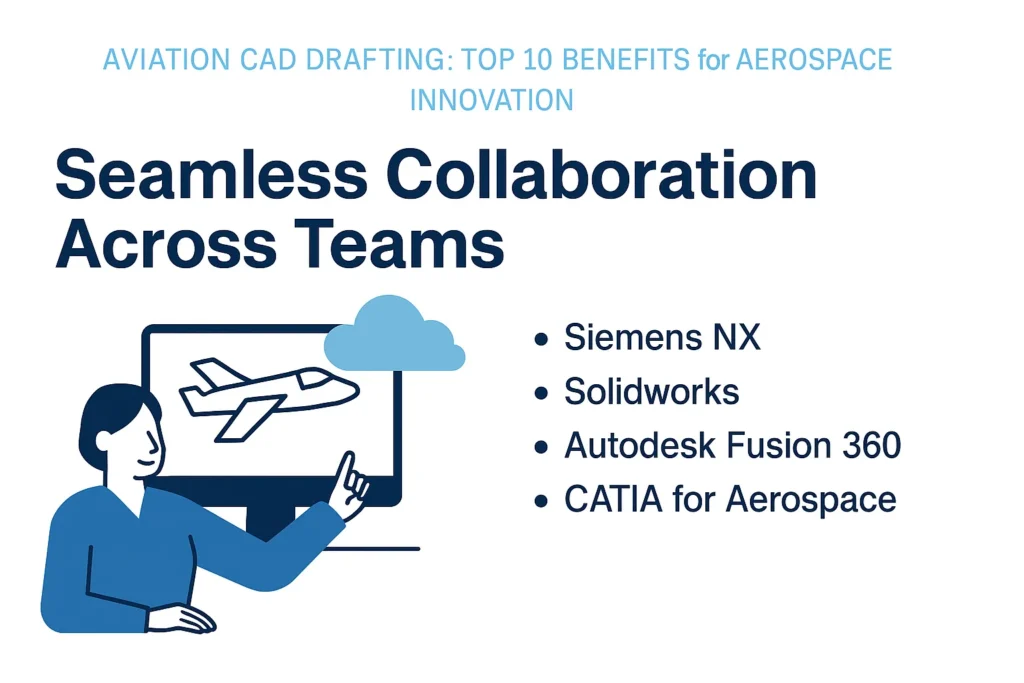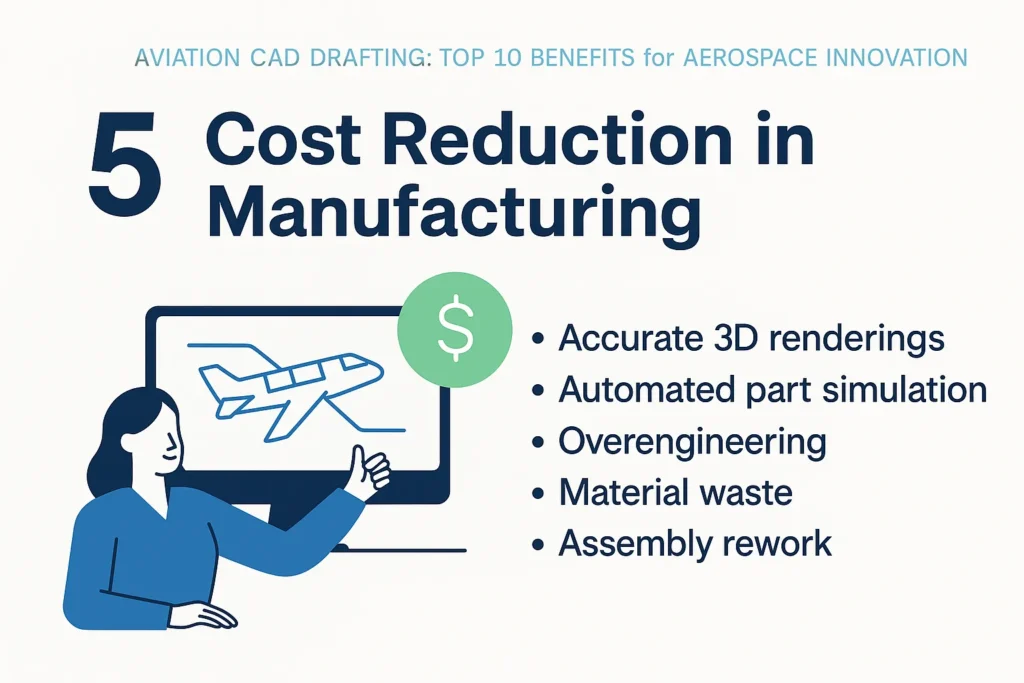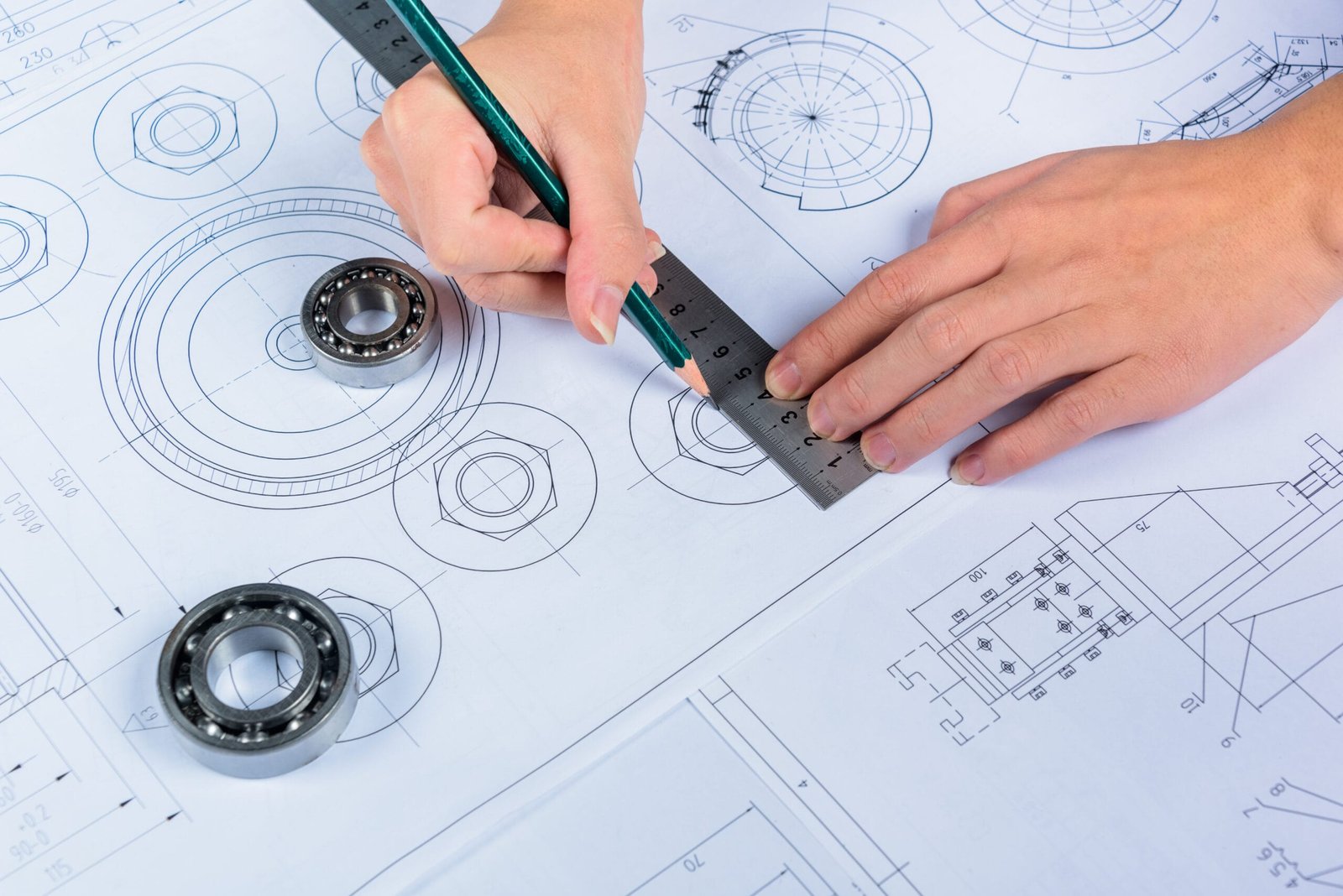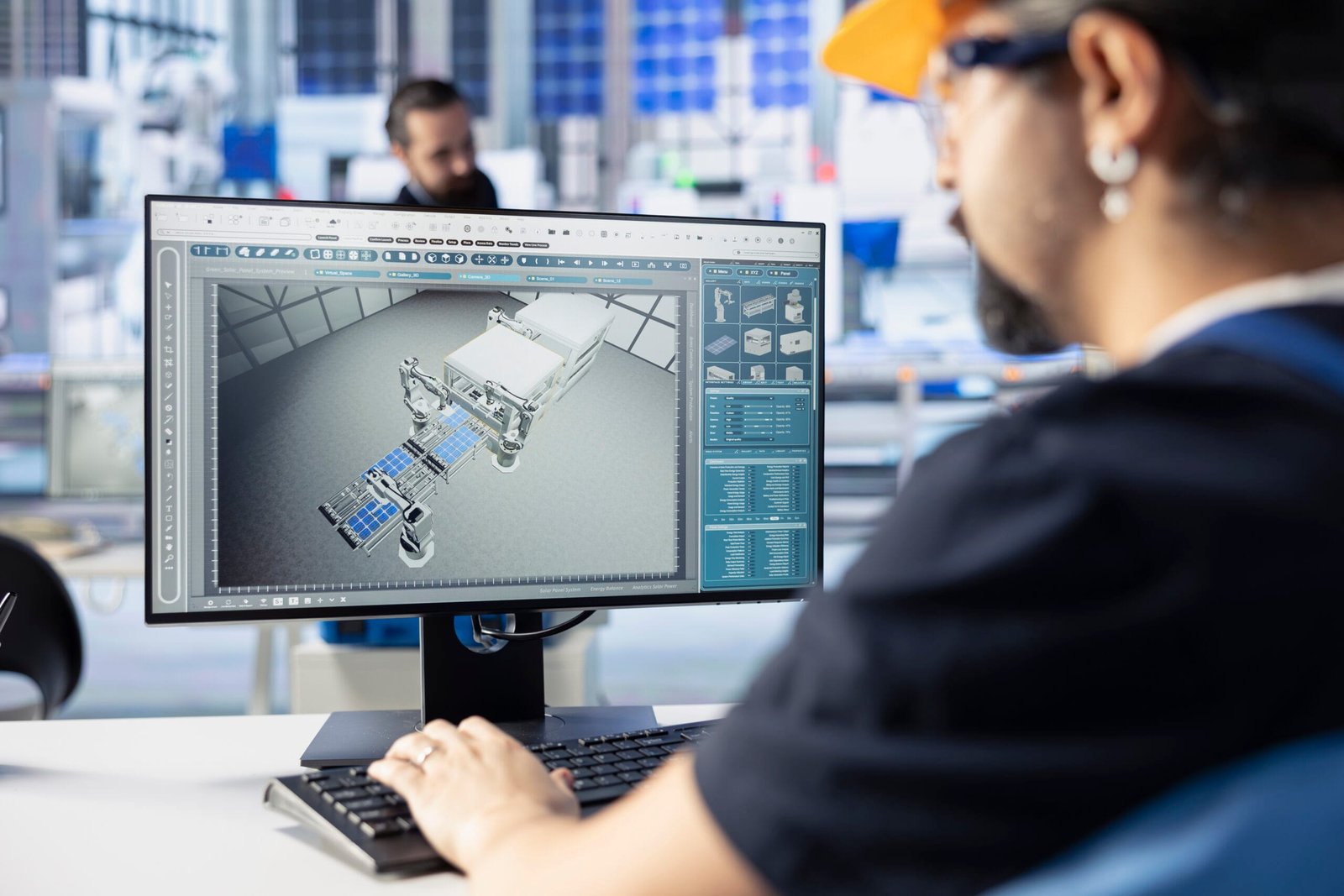Introduction: Why Aviation CAD Drafting Matters
In the fast-paced world of aerospace engineering, aviation CAD drafting has become an indispensable tool for professionals across the industry. Whether designing complex jet components or optimizing interior layouts, CAD (Computer-Aided Design) software helps engineers bring ideas to life with precision and speed. Aviation CAD drafting goes beyond simple 2D drawings—modern systems provide 3D modeling, simulations, and intelligent automation to enhance productivity, reduce costs, and comply with strict aviation standards. This article outlines the top 10 benefits of aviation CAD drafting, highlighting its impact on innovation, safety, and operational efficiency in the aerospace sector.
1- Enhanced Design Precision
Traditional methods lack the accuracy needed for modern aircraft design. Aviation CAD drafting enables micron-level tolerances, which are crucial for:
- Aerodynamic modeling
Aerodynamic modeling
Aerodynamic modeling predicts how air flows around objects like planes or cars. Engineers use it to reduce drag and improve efficiency. Tools like CFD simulate airflow, helping optimize designs for better performance, safety, and fuel economy without the need for expensive, time-consuming physical testing.
Structural integrity
Structural integrity ensures that a structure or component can withstand stress, load, and environmental conditions without failing. Engineers test and design systems to maintain strength and durability over time, preventing damage or collapse during operation.
System integration
System integration connects separate components—hardware, software, or mechanical systems—into a unified, functioning whole. It ensures all parts communicate and operate efficiently together. Common in aerospace and tech industries, integration boosts performance, simplifies upgrades, and is key to building reliable, complex systems.
Aviation components demand the highest levels of accuracy. Even a slight deviation in design can lead to major performance or safety issues. Aviation CAD drafting allows engineers to design parts down to the micrometer. With tools like parametric modeling and associative geometry, changes made to one part of the design automatically update throughout the system. This not only minimizes human error but also ensures design consistency across assemblies. CAD software provides various views—orthographic, isometric, and sectional—which are vital for inspecting every aspect of a design. This level of detail ensures that final components meet exact specifications.
2- Accelerated Time-to-Market
Aviation CAD drafting allows teams to move from concept to prototype quickly. Digital twin technology, integrated into many CAD platforms, simulates real-world stress tests—eliminating multiple rounds of physical prototyping.
In aerospace, speed matters. The faster a new design can move from concept to prototype to production, the more competitive an organization becomes. Aviation CAD Modeling drafting accelerates every stage of the design process. Reusable component libraries, intelligent templates, and simulation tools eliminate the need for repetitive manual drafting. Engineers can conduct digital tests such as airflow simulations and structural stress analysis directly within CAD software, reducing the need for physical prototypes. This not only saves time but significantly cuts R&D costs.
3- Regulatory Compliance Made Easy
Global aviation authorities like FAA and EASA require detailed documentation. CAD tools simplify this by:
Including revision histories for audits
Auto-generating BOMs (Bill of Materials)
Exporting standard-compliant files (e.g., .STEP, .IGES)
Aviation is one of the most regulated industries. Meeting compliance with FAA, EASA, and ICAO standards is mandatory. CAD tools streamline this process by automatically generating compliant documentation. Design history, revisions, part identification numbers, and standard formats like .STEP and .IGES are stored within the CAD files. These files are easy to audit and are compatible with PLM (Product Lifecycle Management) systems, ensuring traceability and accountability for every component.
4- Seamless Collaboration Across Teams
Designers, engineers, and stakeholders can now co-create using cloud-based aviation CAD drafting platforms like:
Siemens NX
Autodesk Fusion 360
CATIA for Aerospace

Large aerospace projects often involve teams distributed across different countries. CAD platforms enable real-time collaboration, with cloud-based systems allowing simultaneous editing and commenting. Engineers, suppliers, quality assurance teams, and manufacturers can work from a single unified model, reducing the chances of miscommunication or version conflicts. Shared digital environments improve transparency and reduce rework. Integration with PDM (Product Data Management) systems also ensures that all stakeholders are working from the latest version of the design.
5- Cost Reduction in Manufacturing
With accurate 3D renderings and automated part simulation, manufacturers avoid:
- Overengineering
- Material waste
- Assembly rework
Result? Cost savings and improved performance.

Aviation CAD drafting helps manufacturers reduce costs in numerous ways. Firstly, accurate designs eliminate errors that can lead to scrapped parts or costly recalls. Secondly, CAD-based simulations identify potential design flaws early, allowing them to be corrected before production. Additionally, CAD systems can integrate with CAM (Computer-Aided Manufacturing) tools, enabling automated and optimized machining processes. Material consumption is also reduced, and machine time is minimized. Together, these improvements contribute to substantial savings across the supply chain.
6- Integration With AI and Automation
Modern CAD software integrates AI for:
- Smart component suggestion
- Predictive stress analysis
- Automated drafting of repetitive geometries
This transforms aviation CAD drafting from a static tool into an intelligent design assistant.
Modern aviation CAD tools are powered by AI and machine learning algorithms. These systems can suggest design improvements, flag inconsistencies, and even generate complete parts based on functional requirements. AI integration makes CAD smarter by learning from historical data to optimize material use, weight, and strength. Automation features like parametric scripts, macros, and templates further reduce repetitive tasks and human error, allowing designers to focus on innovation rather than routine.
7- Improved MRO (Maintenance, Repair & Overhaul)
MRO is a major expense in aviation. With CAD models:
Custom replacement parts can be 3D printed directly from the file
Engineers locate parts quickly
Maintenance schedules are optimized
Maintenance and repair operations benefit significantly from accurate CAD models. Engineers and technicians use digital twins and exploded views to quickly identify issues and plan repairs. CAD models can be integrated into augmented reality (AR) applications, helping technicians visualize internal systems before opening up actual components. Additionally, CAD files are used to create 3D-printed replacement parts, especially for legacy systems where spare parts may be obsolete. This reduces aircraft downtime and enhances fleet readiness.
8- Superior Training and Simulation
Aviation CAD modeling and drafting supports immersive simulations. VR/AR integrations allow:
Real-time interaction with subsystem models
Pilot cockpit walkthroughs
Technician training on virtual aircraft
Training is critical in aviation, and CAD drafting plays an important role in simulation environments. Virtual Reality (VR) and Augmented Reality (AR) training programs often rely on CAD models to simulate real-world scenarios. From pilot training to maintenance workshops, these simulations reduce the need for expensive physical prototypes. CAD-based simulations also allow engineers to practice complex assemblies and test procedures in a risk-free environment.
9- Digital Archiving and Lifecycle Management
Gone are the days of dusty blueprints. Aviation CAD files offer:
Lifecycle management from cradle to grave
Long-term version control
Metadata tagging for easy search
A CAD system doesn’t just create models—it stores comprehensive information about a part’s lifecycle. Metadata such as material types, revision history, tolerance levels, and test results are stored within the design. Lifecycle management tools enable companies to track each component from initial concept to decommissioning. This supports efficient inventory control, maintenance planning, and end-of-life strategies. In aviation, where parts can remain in service for decades, such record-keeping is essential.
10- Competitive Edge in Aerospace Contracts
Clients and contractors value precision and documentation. A robust aviation CAD modeling and drafting system:
Enhances company reputation in global markets
Wins contracts faster
Shortens negotiation cycles
Clients and governments look for reliability, transparency, and innovation. A company using advanced aviation CAD drafting tools can offer detailed visualizations, quick design modifications, and accurate cost projections—winning points in competitive bids. High-quality CAD models can be used in presentations, virtual walk-throughs, and customer training. CAD-backed proposals are more likely to gain approval from regulatory authorities and investors alike. The use of aviation CAD drafting also demonstrates a company’s commitment to quality, efficiency, and technological advancement.
Common Use Cases in the Aviation Industry
Jet Engine Drafting
Cabin Interior Layout
Drone Component Prototyping
Landing Gear Geometry Optimization
Aviation CAD Modeling and Drafting Tools to Consider
Here are leading platforms for aviation-specific projects:
| Software | Notable Feature |
|---|---|
| CATIA | Used by Airbus and Dassault |
| SolidWorks | Popular for prototyping |
| Siemens NX | Great for enterprise integration |
| AutoCAD | Legacy 2D/3D drafting |
FAQs: Aviation CAD Drafting
Q1: Is aviation CAD modeling and drafting suitable for small UAV startups?
Yes. It ensures scale, compliance, and modular design efficiency, even for lean teams.
Q2: How do I choose the right CAD software for aviation projects?
Consider certification requirements, team skill level, integration needs, and customer expectations.
Q3: What file formats are commonly used in aviation CAD drafting?
.STEP, .IGES, .DXF, and .DWG are widely supported across systems.
Q4: Can CAD drafting improve sustainability in aviation?
Absolutely. CAD allows for lighter, more fuel-efficient design iterations that reduce environmental impact.
Final Thoughts
Aviation CAD drafting is the invisible engine driving aerospace progress. From conceptual design to MRO and simulation, it empowers teams to build smarter, fly safer, and grow faster. Adopting CAD is not just a technical upgrade—it’s a strategic advantage.
Need expert help with aviation CAD drafting for your aerospace project? Contact DesignHok — your trusted partner in precision drafting.





